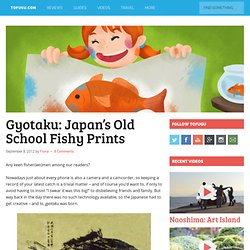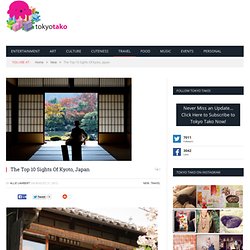

TOP of edo shokunin - 江東区伝統工芸会. 絵本作家 岡田千晶のホームページ. Riusuke Fukahori Paints Three-Dimensional Goldfish Embedded in Layers of Resin. First: watch the video.

Japanese artist Riusuke Fukahori paints three-dimensional goldfish using a complex process of poured resin. The fish are painted meticulously, layer by layer, the sandwiched slices revealing slightly more about each creature, similar to the function of a 3D printer. I really enjoy the rich depth of the pieces and the optical illusion aspect, it’s such an odd process that results in something that’s both a painting and sculptural. Wonderful. Уважаемые Японии Vimeo. UDくまもと公式ブログ 「みなよか日記」 よわよわカメラウーマン日記. JAPANESE DESIGN. Issekinicho - Nightly. Mardi 11 juin | 2013 Dépaysement en bas de chez soi. par aAlex On découvre de plus en plus Strasbourg et ses alentours, il y a encore du boulot pour placer tous les villages sur la carte, mais la région mérite qu’on la découvre.

Dédicaces Ce week-end le samedi 15 et dimanche 16, nous serons en dédicaces à Japan addict à Strasbourg. 13 commentaires Jeudi 14 mar | 2013 La vie à Higashi-Tamagawagakuen : Les voisins épisode 03 Les voisins avaient réussi à faire plier l’agence pour couper les arbres. エカキクマ. Japanese illustration. Gyotaku: Japan’s Old School Fishy Prints. Any keen fisher(wo)men among our readers?

Nowadays just about every phone is also a camera and a camcorder, so keeping a record of your latest catch is a trivial matter – and of course you’d want to, if only to avoid having to insist “I swear it was this big!” To disbelieving friends and family. But way back in the day there was no such technology available, so the Japanese had to get creative – and lo, gyotaku was born. The oldest known gyotaku print is that of a carp, and is from 1839. Gyotaku (魚拓) or “fish rubbing” dates back to at least the Tempou era, and is still in practice today.
The two main variants, namely the direct and indirect methods, both use inks to transfer the likeness of the fish to a sheet of paper or cloth. Mineo Yamamoto has been a gyotaku artist since 1973, and a great proponent of the indirect method. As you might have guessed, a skilled gyotaku artist can produce incredibly detailed and lifelike images, especially if colored inks are used. Header image. Микро дома. Cold Spring на Vimeo. 宮田雅之切り絵の世界 The world of Masayuki Miyata. Naoko Matsubara. Boooook. November 23, 2014 November 21, 2014 「東京ミキサー計画 ハイレッド・センター直接行動の記録」 赤瀬川原平 Parco出版局 読了。

2 days ago [High-Res] 54 notes Tag: 赤瀬川原平© Parco出版局© November 20, 2014 「自由こそ治療だ イタリア精神病院解体のレポート 」ジル・シュミット 社会評論社 読了。 2 days ago [High-Res] 16 notes Tag: ジル・シュミット© 社会評論社© November 19, 2014 「ひきこもりの〈ゴール〉「就労」でもなく「対人関係」でもなく」石川良子 青弓社 読了。 3 days ago [High-Res] 13 notes Tag: 石川良子© 青弓社© November 18, 2014. Gyotaku Images. Momoda Yukari. Yamamoto masao works/kawa-1. Heisuke Kitazawa or PCP web. Tori. ギャラリー. Hello sandwich. スタンダード通信社 & LOWE TOKYO. Japanese graphic design from the 1920s-30s. In the 1920s and 1930s, Japan embraced new forms of graphic design as waves of social change swept across the nation.

This collection of 50 posters, magazine covers and advertisements offer a glimpse at some of the prevailing tendencies in a society transformed by the growth of modern industry and technology, the popularity of Western art and culture, and the emergence of leftist political thought. "Buy Domestic! " poster, 1930 [+] Cover of "Nippon" magazine issue #1, Oct 1934 [+] "Fuji Weekly" cover, Oct 1930 [+] Poster for Japan's first national census, 1920 [+] // "Health for body and country" poster, c. 1930 [+] Grand Nagoya Festival poster by Kenkichi Sugimoto, 1933 [+] Kyoto Grand Exposition to Commemorate the Showa Imperial Coronation, 1928 [+] Poster design by Shujiro Shimomura, 1928 [+] "NAPF" (Nippona Artista Proleta Federacio) magazine cover, Feb 1931 [+] "NAPF" (Nippona Artista Proleta Federacio) magazine covers: Sep 1931 // Oct 1931.
Top sights of kyoto. When people first consider the idea of a holiday in Japan, their thoughts usually turn to Tokyo.

Now, there’s nothing wrong with Tokyo – its soaring skyscrapers perfectly contrasting with its sombre temples – but there is a lot more to Japan than the bright lights of its world famous capital. Take Kyoto, for example. The city is the historical and cultural capital of Japan – a fine mix of urban sprawl and cultural gems. Indeed, Kyoto was home to the Japanese Imperial family from 794 all the way up to 1868 when the Emperor decided to relocate to Tokyo.
Kyoto is one of the few major Japanese cities to avoid the destruction of aerial raids during World War 2, and aside from anything else that makes it a fascinating part of any holiday in Japan. How much time you wish to spend in this amazing city is mainly down to your tastes in sightseeing. Heian Jungu This Shinto shrine is famous for having the largest torii in the whole of Japan. Gion Kinkakuji (Golden Pavilion Temple) Japan photography.